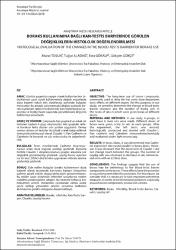| dc.contributor.author | Tosun, Murat | |
| dc.contributor.author | Aladağ, Tuğçe | |
| dc.contributor.author | Gökalp, Esra | |
| dc.contributor.author | Gökçe, Gökçen | |
| dc.date.accessioned | 2019-01-23T13:22:41Z | |
| dc.date.available | 2019-01-23T13:22:41Z | |
| dc.date.issued | 2018 | |
| dc.identifier.uri | http://dergipark.gov.tr/download/article-file/561454 | |
| dc.identifier.uri | http://hdl.handle.net/11630/5215 | |
| dc.description.abstract | AMAÇ: Günlük yaşantıda yaygın olarak kullanılan bor bileşiklerinin
uzun süreli kullanımında değişik organlarda
doza bağımlı toksik etki olabileceği yönünde bulgular
mevcuttur. Bu amaçla çalışmamızda değişik dozlarda boraks
kullanılan ratların testislerinde kan-testis bariyeri yapısında
ve leydig hücre sayısında görülebilecek değişimi
belirlemeyi amaçladık.
GEREÇ VE YÖNTEM: Çalışmada her grupta 6’şar erkek rat
bulunan toplam 4 grup oluşturuldu. Her gruptaki ratlara
boraksın farklı dozları oral yoldan uygulandı. Deney
sonrası alınan sol testisler histolojik olarak takip edilerek
immunohistokimyasal olarak Claudin-1, Pan Cadherin ve
Calretinin ile boyandı ve ışık mikroskobu ile değerlendirildi.
BULGULAR: Testis örneklerinde Cadherin ekspresyonunun
artan doza bağımlı azaldığı gözlendi. Bununla
birlikte Claudin 1 ekspresyonunun gruplar arasında çok
değişiklik göstermediği gözlendi. Leydig hücre sayısının
ise bir kez LD50x2 doz boraks uygulanan ratlarda azalma
gösterdiği gözlendi.
SONUÇ: Elde edilen bulgular boraks kullanımının doza
bağımlı olarak testislerde kan-testis bariyeri bileşenleri
üzerine zararlı etkiler oluşturabileceğini göstermektedir.
Bu etkiler uzun dönemde infertilite sorunlarına neden
olabilme potansiyeline sahiptir. Bu nedenle bilhassa bor
bileşenleri üretim merkezleri çevresinde olmak üzere
çevre kirliliği yönünden önemli korunma tedbirleri
alınmasının gerekli olduğunu düşünmekteyiz. | en_US |
| dc.description.abstract | OBJECTIVE: The long-term use of boron compounds
commonly used in daily life has some dose-dependent
toxic effects on different organs For this purpose, in our
study, we aimed to determine the change in blood-testis
barrier structure and the number of leydig cells in
the testis of rats in which were given borax at different
doses.
MATERIAL AND METHODS: In our study, 4 groups, in
each have 6 male rats were made. Different doses of
borax were given orally to rats in each groups. After
the experiment, the left testis was excised,
histologically processed and stained with Claudin-1,
Pan cadherin and Calretinin immunohistochemically
and evaluated under light microscopy.
RESULTS: In testis slides, it was determined that Cadherin
expression decreased parallel to borax doses. However,
it was observed that the expression of Claudin 1 did
not change much between the groups. The number of
Leydig cells was observed to decrease in rats administered
once with an LD50x2 dose.
CONCLUSIONS: The findings suggest that the use of
borax may be deleterious to the blood-testis barrier
components in the testes. These effects have the potential
to cause long term infertility problems. For this reason, we
consider that it is necessary to take important preventive
measures in terms of environmental pollution, especially
around boron components production centers. | |
| dc.language.iso | tur | en_US |
| dc.publisher | Afyon Kocatepe Üniversitesi, Kocatepe Tıp Dergisi | |
| dc.identifier.doi | 10.18229/kocatepetip.475003 | en_US |
| dc.rights | info:eu-repo/semantics/openAccess | en_US |
| dc.subject | Boraks | |
| dc.subject | İnfertilite | |
| dc.subject | Kan-Testis Bariyeri | |
| dc.subject | Claudin | |
| dc.subject | Leydig Hücresi | |
| dc.subject | Borax | |
| dc.subject | Infertility | |
| dc.subject | Blood-Testis Barrier | |
| dc.subject | Claudin | |
| dc.subject | Leydig Cell | |
| dc.title | Boraks kullanımına bağlı Kan-Testis Bariyerinde görülen değişikliklerin histolojik değerlendirilmesi | en_US |
| dc.title.alternative | Histological evaluation of the changes in the Blood-Testis Barrier for boraks use | en_US |
| dc.type | article | en_US |
| dc.relation.journal | Afyon Kocatepe Üniversitesi, Kocatepe Tıp Dergisi | en_US |
| dc.department | Afyonkarahisar Sağlık Bilimleri Üniversitesi, Tıp Fakültesi, Histoloji ve Embriyoloji Anabilim Dalı | |
| dc.department | Afyonkarahisar Sağlık Bilimleri Üniversitesi, Tıp Fakültesi, Histoloji ve Embriyoloji Anabilim Dalı | |
| dc.identifier.volume | 19 | en_US |
| dc.identifier.startpage | 139 | en_US |
| dc.identifier.endpage | 144 | en_US |
| dc.identifier.issue | 4 | en_US |
| dc.relation.publicationcategory | Makale - Ulusal Hakemli Dergi - Kurum Yayını | en_US |



















